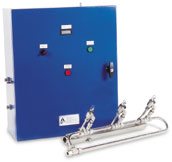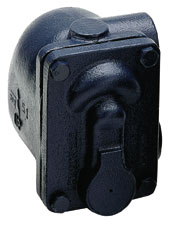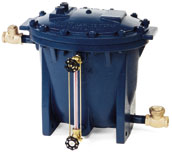Product List
Find a product
Information
Armstrong Cool-Fog® Systems
Description

How foggers operate
Armstrong Cool-Fog Systems use both compressed air and pressurized water to achieve atomization. Pressurized water is injected in the discharge orifice of a compressed air system. As the compressed air is discharged through an orifice, the air’s potential energy is converted to kinetic energy, which is imparted to the injected water.
The rapidly moving mixture experiences pressure fluctuations and eddy currents, which break up the water stream into atomized water particles. The mixture of atomized water and expanding air is discharged through an orifice and deflected off a resonator tip, which further reduces the water particle size and spreads the atomized water and air mixture. (See drawing.) The final product is fog.
Armstrong currently manufactures and markets the following systems for environmental-control applications:
- Cool-Fog Systems
(CF) for use with potable or reverse osmosis purified water in
commercial and industrial applications. All wetted parts are stainless
steel, brass or copper. - Pure Fog Systems (PF) for use
with de-ionized water in clean rooms, laboratories, semiconductor
facilities and other ultra-clean industrial applications. All wetted
parts are stainless steel. - Standard Proportional Systems (STD)
for air-handler or duct applications. Available as CF or PF. For
reduced-evaporation distance requirements with medium to high
compressed-air consumption rates and 50:1 control modulation. - Variable Differential Control Systems (VDC)
for air-handler or duct applications. Available as CF or PF. For
reduced compressed-air consumption rates and 100:1 control modulation. - HumidiComp (HC), ON/OFF Systems
for air-handler or duct applications. Available as CF or PF. For reduced
cost compared to STD and VDC Systems. Recommended only for fixed
outside air rates and stable humidification loads. - Direct Area Discharge (DDF), ON/OFF systems for direct area discharge. Available as CF or PF.



